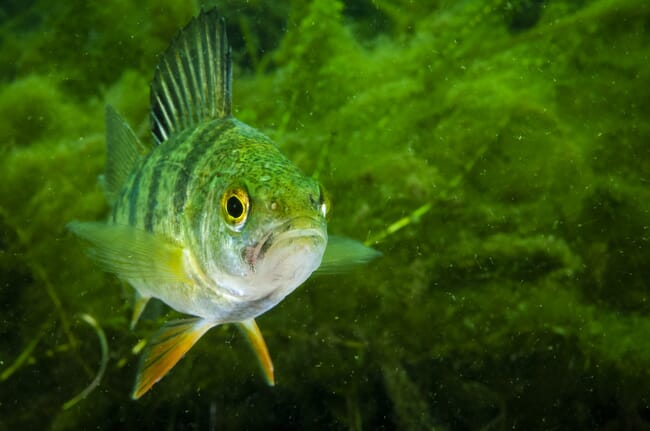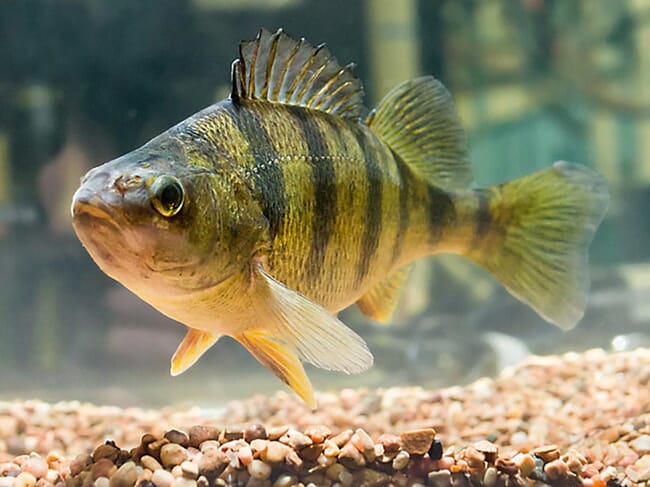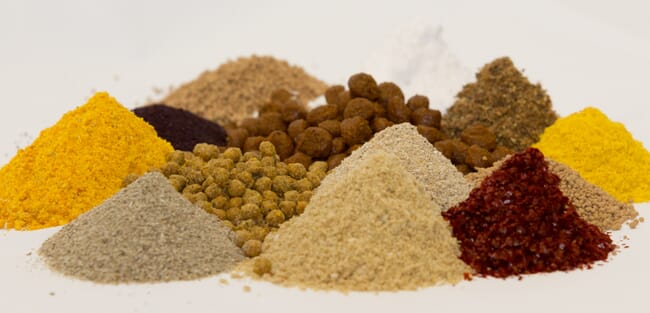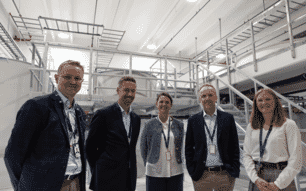
From the left are Michal Wojno, assistant scientist with the Center for Fisheries, Aquaculture, and Aquatic Sciences; Giovanni Molinari, graduate student; Karolina Kwasek, assistant professor in the School of Biological Sciences and Peter Boessen, graduate student © Russel Bailey
Karolina Kwasek and Michal Wojno are trying to find better ways to hatch and successfully raise yellow perch to the juvenile stage in aquaculture. They are using research methods that combine low-tech hatchery equipment, easily copied by professional fish farmers, with creating a new feed that uses the invasive species copi as a protein source.
The research will last through 2023. Success would mean greatly increasing yellow perch’s survival rates at indoor hatcheries, leading to business expansion for more aquacultural ventures and better prices for consumers.
Tender loving care
Yellow perch and other percids, such as walleye, are among the most difficult freshwater fish to raise in captivity. The very few aquaculture operations that even attempt to raise perch indoors report less than 10 percent success rate in nursing them from the larval to the juvenile stage.
Much of the difficulty stems from successfully feeding them because the newly hatched larvae are picky eaters with many limitations. Expensive, high-maintenance live feed is the standard; creating a cost-effective dry feed would revolutionise the process.
“It’s been very difficult finding a solution for not just the right nutritional composition of food, but also making it digestible and palatable to the larvae,” Kwasek said.
Overall water quality also plays a major role, making outdoor systems such as ponds – that come with predators and unpredictable external influences – a very difficult proposition. But even indoors, challenges remain.
One of those is creating conditions that allow the larva to break the surface tension of the water – often coated with an oil created by the hatching activity, letting them to fill their swim bladders with air – a critical manoeuvre for survival that helps them control their buoyancy.

The researchers have designed the system with materials that are easily obtainable and are using processes that can be easily replicated
Building the right system
In one of the fisheries buildings near McLafferty Annex at SIU, Wojno and Kwasek have set up a series of percid systems designed to more closely resemble a fish farm than a sterile scientific laboratory.
“Whatever we do, fish farmers must be able to replicate it at their operation. It’s designed with materials that are easily obtainable and put together,” Kwasek said.
The hatcheries consist of plastic tanks with strategically placed water nozzles that not only break up the surface tension but also circulate the water in ways that mimic a natural environment. Adding clay to the water also minimises the larvae’s cannibalistic tendencies.
Much of the day-to-day, often round-the-clock care of the tiny creatures falls on the shoulders of graduate students like Peter Boessen, who studies zoology. He began working on the project in January.

© USDA
His tasks include siphoning and scrubbing waste from each tank and feeding the approximately 25,000 surviving yellow perch. The larvae are renowned for their finicky behaviour during early life stages, and one of the biggest challenges is remaining consistent in their care throughout the entire process.
They require undivided attention, especially during the first week or so after hatching from eggs. If the proper feed isn’t present once they absorb the nutrients in their yolk sack, most will die.
“It can feel very nerve-racking and high-risk early on, from cleaning tanks, to checking water quality, to feeding five or six times a day,” he said.
Utilising an invasive species
Having the correct care in the well-designed facility is important, but researchers’ efforts also centre on creating a better feeding option for the larvae – an almost impossible challenge given the tiny, immature creatures’ limited mobility, eyesight and immature gut.
“Larval fish nutrition is a constant bottleneck to further growth of the hatchery sector,” Wojno said. “Developing accepted and cost-effective diets that will help eliminate expensive live food will reduce costs, provide more control and intensify fish production.”
Kwasek, an assistant professor in the School of Biological Sciences, and Wojno, an assistant scientist with the Center for Fisheries, Aquaculture, and Aquatic Sciences, may have found a way to bridge that gap. Their approach might also lead to an expanded market for copi (previously known as Asian carp), an invasive species that threatens Illinois waterways.
Breaking it down
Scientists are looking for ways to mitigate copi, a large invasive fish that shows no sign of going away soon. One way is by utilising its large, muscular build as a potential protein source.
The SIU researchers are exploring ways to convert the copi protein into a new feed for the larvae essentially by pre-digesting it in-vitro. Mixing protein from copi with the enzyme-laden digestive tracts of processed mature perch, and then incubating the resulting slurry at temperatures and pH levels that mimic the digestive process, breaks the copi protein into molecular sizes that the larvae can absorb.

The researchers have been able to pre-digest protien sources and convert them into pelletised aquafeed © tcfat
The process can only take a few hours and can be slowed down or sped up by controlling the ratio of digestive enzymes to the raw protein. The final dried product is turned into pellets so small that they appear as powder to the human eye.
A fish farmer can place this new food directly into the tanks holding the larvae, where the water circulation controlled by the nozzles in Wojno and Kwasek’s design also help keep the new experimental food from sinking too quickly, moving it horizontally longer and giving the larvae a chance to discover the new dish.
“It’s mostly by chance; they just bump into it and they learn to eat it,” Kwasek said. “They even learn this from each other.”
Promising early results
In addition to opening another market for the invasive species, Kwasek hopes the research will help aquaculture farmers ramp up productivity of the desirable fish meat and game fish such as walleye, their next target.
“It could potentially change the way the aquaculture industry is conducted everywhere,” she said. “Not many fish farmers do indoor hatchery operations, but when you think about the economics, indoor culture makes more sense because you get more fish at the end. They grow faster, and no one wants to deal with live food like they use now. With a pelletised food, you can pretty much drop it into the tank if they will eat it and grow on it. That’s what we’re hoping achieve.”
And it’s working. The methods already have raised the survival rate to around 50 percent with swim bladder inflation of nearly 100 percent.
“So, this is potentially a major breakthrough for larvae culture in general,” Kwasek said.




